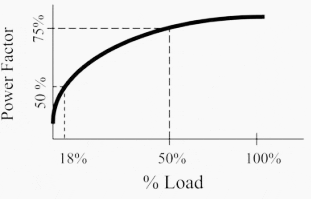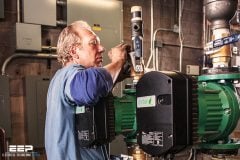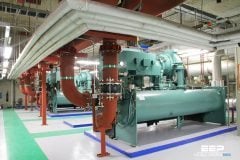Load Efficiency
Three-phase squirrel-cage induction motors comprise a considerable percentage of the electrical load in the United States. Design, operation, and maintenance of these machines is well described in some of the articles already published. This article focuses on their energy efficiency aspects.

Induction motors typically range in full load efficiency from about 87% to 94%. This efficiency is very difficult to measure accurately in the field, requiring a dynamometer and other specialized equipment. Fortunately, energy saving projects associated with electric motors do not require actual efficiency of a given motor to be established.
Rewinding a damaged induction motor is a common practice in industry, but studies have proven that rewinding an induction motor drops its efficiency by a couple percentage points. Multiple rewinds can further reduce the efficiency of the rewound motor.
While a drop in efficiency from 89% to 88% seems insignificant, a quick estimate reveals that this reduction can be costly. A standard efficiency 20 hp motor operating 8000 hours annually, for example, costs about $7000 per year to operate at an average electricity rate of 7 ¢/kWh. Once this motor fails, the least-cost option for returning it to service is typically rewinding.
The incremental cost of replacing this failed motor with an energy-efficient motor, however, is only $430. This amount assumes considers the rewound cost, and the labor necessary to perform the motor change-out, as sunk costs.
The annual energy savings associated with replacing the failed motor with an energy-efficient model, at a new efficiency of 92.9%, is approximately $510. The simple payback for the replacement, therefore, is less than one year.


Energy-efficient motor programs are applicable to any AC motor installations utilizing NEMA Design B induction motors. Since the programs are based on replacement at failure, the full savings potential is realized after three years or more.
Published efficiencies of typical rewound, standard, and energy-efficient three-phase induction motors.
| HP | Rewound Efficiency | Standard Efficiency | Energy Efficient Efficiency |
| 1 | 69.7% | 70.7% | 82.6% |
| 2 | 79.5% | 80.5% | 83.4% |
| 3 | 79.4% | 80.4% | 86.6% |
| 5 | 81.4% | 82.4% | 88.3% |
| 8 | 83.1% | 84.1% | 90.0% |
| 10 | 85.1% | 86.1% | 91.1% |
| 15 | 85.5% | 86.5% | 92.0% |
| 20 | 87.3% | 88.3% | 92.9% |
| 25 | 88.0% | 89.0% | 93.5% |
| 30 | 88.1% | 89.1% | 93.7% |
| 40 | 88.7% | 89.7% | 94.2% |
| 50 | 90.0% | 91.0% | 94.4% |
| 60 | 89.9% | 90.9% | 94.7% |
| 75 | 90.4% | 91.4% | 94.9% |
| 100 | 90.4% | 91.4% | 95.4% |
| 125 | 90.6% | 91.6% | 95.3% |
| 150 | 91.5% | 92.5% | 95.7% |
Motor Rewinding Process (VIDEO)
What is the rewind scenario if a motor fails? Read more about rewind “rules of thumb”.
Cant see this video? Click here to watch it on Youtube.
Reference: Electrical Energy Management – Bill Brown, P.E., Square D Engineering Services











Is converting the motor from Delta connected to Star connected worth ? (motors which are running on load less than 50%)
Basically, there are three losses in an any motor… being windage, copper and iron losses.
Firstly, a star-connected motor running at 50% (Kw) will probably burn out, as the coil current will be > 1pu coil current. Try about 33%
A star-connected motor will reduce the iron losses because the effective voltage is reduced to 1/1.732.
The windage will be the same (because the star and delta speeds are dictated by the pole count.
This leaves the copper losses. The copper losses would be the same connected in star at 30% as they would be delta connection @100% (I think)
While ‘old’ motors contain a lot more iron than ‘new’ ones one of a similar rating one would assume, and a ‘new cheap’ motor will run a lot hotter than an ‘old one’. This would explain the low efficiency of a ‘cheap’ motor.
Is it possible that the new ‘high efficiency’ motors merely replicate the conservative design concepts of yester-year of more and good quality steel with thinner laminations: and thicker copper coils of better refined copper???
With all of the above, I find it difficult to understand why a rewound motor would be less efficient than a new one, given that modern coil winding technology can make a motor run cooler because the newer technologies give rise to better heat transfer from the internals of the coils..
Glad to here other opinions…
Interesting article! Bit, what about 250, 400, 600 HP motors, talking about payback? In tour article have you considered NEW motor replacement?
Thanks!